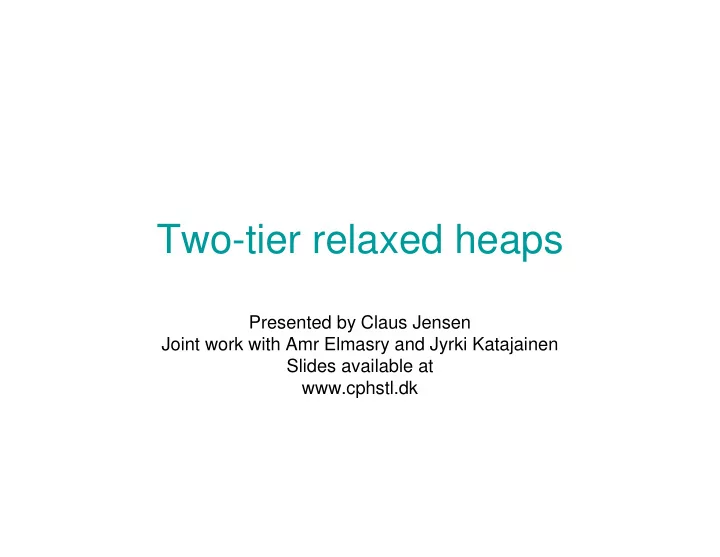

Two-tier relaxed heaps Presented by Claus Jensen Joint work with Amr Elmasry and Jyrki Katajainen Slides available at www.cphstl.dk
Heaps • Our focus has been on the worst-case comparison complexity of the heap operations: – Find-min – Insert – Decrease(-key) – Delete • The following heaps support decrease at O(1) cost in the worst case: – Run-relaxed heaps (Driscoll et al. 1988) – Fat heaps (Kaplan and Tarjan 1999) 2
Worst-case complexity bounds • The number of element comparisons performed in the worst case Run-relaxed Fat heaps heaps Find-min O(1) O(1) Insert O(1) O(1) Decrease O(1) O(1) Delete 3lg n + O(1) 2.6lg n + O(1) 3
Our two-tier relaxed heaps • A two-tier relaxed heap has the following complexity bounds. Number of element Worst-case comparisons cost Find-min O(1) O(1) Insert O(1) O(1) Decrease O(1) O(1) Delete lg n+3lglg n+O(1) O(lg n) 4
Two-tier relaxed heaps • A two-tier relaxed heap is composed of two run-relaxed heaps relying on a redundant zeroless representation • Next: Number representations vs. data structures 5
A binomial heap using binary representation • M = 111 two Digits = {0, 1} • A binomial heap storing 7 integers which are kept in 3 binomial trees and stored in heap order within the trees • The rank of a binomial tree is equal to the number of children of the root 6
A binomial heap using redundant binary representation • M = 202 redundant two Digits = {0, 1, 2} • A binomial heap storing 10 integers 7
A binomial heap using redundant zeroless representation • M = 214 redundant four Digits = {1, 2, 3, 4} • A binomial heap storing 14 integers 8
Zeroless number system • Addition – M + 1 – Corresponds to inserting a node into the binomial heap • Subtraction – M – 1 – Corresponds to extracting a node from the binomial heap 9
Insert and extract • Using functionality which incrementally handles carries and borrows in the zeroless number system, both addition and subtraction can be accomplished at constant cost • When using a carry/borrow stack to provide this functionality in the context of binomial heaps, both insert and extract can be performed at constant worst-case cost • Next: Run-relaxed heaps 10
Run-relaxed heaps • A run-relaxed heap is composed of relaxed binomial trees which are almost heap-ordered binomial trees • Some nodes can be marked active indicating that there may be a heap-order violation • The maximum number of active nodes is ⎣ lg n ⎦ (Driscoll et al. 1988) • A singleton is an active node which has no active siblings • A run is a sequence of consecutive active siblings 11
Run-relaxed heaps • A series of run/singleton transformations is used to reduce the number of active nodes • Illustrated with one of the singleton transformations 12
A run-relaxed heap • A run-relaxed heap storing 10 integers. The relaxed binomial trees are drawn in schematic form and active nodes are drawn in grey 13
Two-tier relaxed heap components • A two-tier relaxed heap has the following components: – An upper store which contains pointers to roots and active nodes held in the lower store – A lower store which contains the elements of the heap • The two components are run-relaxed heaps using the redundant zeroless number system 14
A two-tier relaxed heap • A two-tier relaxed heap storing 12 integers 15
Extra functionality at the upper store • Lazy deletions: Sometimes nodes in the upper store are marked instead of being deleted – When the number of marked nodes reaches half of the total number of nodes, the marked nodes are removed by an incremental global rebuilding 16
Heap operations • Find-min: – The upper-store find- min operation is called, and this operation returns either one of the roots or one of the active nodes 17
Heap operations • Insert: – The lower-store insert operation is called which adds a new node to the lower store – A pointer to that node is inserted into the upper store – If due to a join of two trees a node is no longer a root, the pointer in the upper store associated with that node is marked 18
Heap operations • Decrease: – After the element replacement the node is made active – If the number of active nodes has become too large, a constant number of transformations (singleton or run) is performed – A pointer to the node is inserted into the upper store 19
Heap operations • Delete: – Lower store: The node is removed. A node is extracted, and this node and the roots of the former subtrees are joined together into a new tree – If deletion involves an internal node, the new root of the subtree is made active – Upper store: A pointer to the new root is inserted. If there exists a pointer to the removed node, it is deleted. 20
New contribution • The introduction of extract • Improved constant factors for delete 21
Open problems • Constant factors for the find-min, insert, and decrease operations should be improved • Can the bound for delete be improved to log n + O(1)? (this can be obtained when decrease is not supported) 22
Related work • Amr Elmasry, Claus Jensen, and Jyrki Katajainen. Relaxed weak queues: an alternative to run-relaxed heaps . CPH STL Report 2005-2 • Amr Elmasry, Claus Jensen, and Jyrki Katajainen. On the power of structural violations in priority queues . CPH STL Report 2005-3 • Both available at www.cphstl.dk 23
Recommend
More recommend